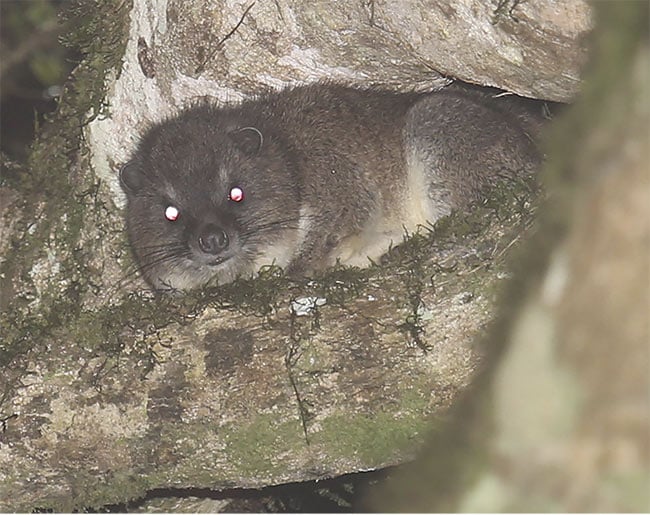
Wildlife tracking takes to the trees
Endangered animals, quite understandably, do their best not to be found. So it took the aid of sophisticated imaging and recording technology for a team of researchers from Finland and the U.K. to capture the habits and movements of tree hyraxes in the mountains of Kenya.
Tree hyraxes, mainly found in Africa, are nocturnal mammals with a guinea pig-like appearance that, as their name suggests, spend a lot of time in trees.

A tree hyrax. The animals dwell in the shrinking forests of the mountains of Kenya. Courtesy of Hanna Rosti.
Takeaways from the researchers’ study included: the higher in trees the better for an individual animal’s survival, and the bigger the forested areas the better for providing food and shelter to tree hyrax communities. The animals also know not to talk until the lights are out.
The habitat of the tree hyraxes was studied in the fragmented forests of the Taita Hills in southeastern Kenya. There, the researchers determined that the animals seek cover that provides both protection and a potential escape route, and that the animals also reserve much of their audible communication for a limited number of hours in the middle of the night, when they stand the best chance of eluding predators or poachers.
The scientists tracked the creatures not with a keen nose or a decoy, but via an array of high-tech modalities. They used audio recorders to capture the sounds made by the tree hyraxes. They used red beam flashlights to find the animals in the tree canopy, and a thermal imaging camera to determine the density of the population once it was discovered. To determine the size and structure of the forest canopy that the animals call home, the team analyzed lidar data that had been collected using an airborne sensor five years earlier.
The animals prefer to live in and eat from montane, or cool and moist forests with tall, canopied trees. In the study, the tree hyrax population thrived the most in three specific areas where the forest landscape was large and undisturbed, and the researchers urged conservation efforts to preserve these areas.
“[Tree hyraxes] prefer certain tree species. In Taita Hills, they like Tabernaemontana, Macaranga, and Pauteria (among others),” said Hanna Rosti, a doctoral candidate in wildlife biology research at the University of Helsinki, and a principal author of the study. “These trees often grow very large, and they provide nice platforms where [the animals] can rest. Tree hyraxes rest and sleep a lot, and their ecological niche is the same as in koalas in Australia and sloths in South America. Also, woody lianas, creepers, form dense nests around the trees. Tree hyraxes feed on these climbers and they also find safe sleeping sites inside the climbers. These are like tree hollows that are also used by tree hyraxes.”
A spectrogram was used to distinguish between the calls of individual animals, she said, so that the hyraxes’ communication could be isolated. Red light was used instead of white to avoid disturbing or scaring them. A wide angle on the thermal imaging camera enabled the researchers to scan the canopy as thoroughly as possible.
Despite the high-tech arsenal that the team entered the forest with, proper observation still took time. “In recordings, we get long-distance communication,” Rosti said. “And from this long-distance calling, it is often impossible to know what they are exactly communicating about. However, we have been to the forest for months and have seen and heard many things. For example, when a predator approaches tree hyrax juveniles, there is a clear alarming, warning pitch in the calls. We have also heard and recorded trees falling, which results in an elaborate calling that has a concerned pitch.”
The lessons learned in the study were simple: There is safety in numbers, and tone of voice matters when addressing each other.
The team’s efforts could lead to more effective conservation of tree hyraxes by shining more light on the type of environment needed to ensure their survival.
Published: September 2022